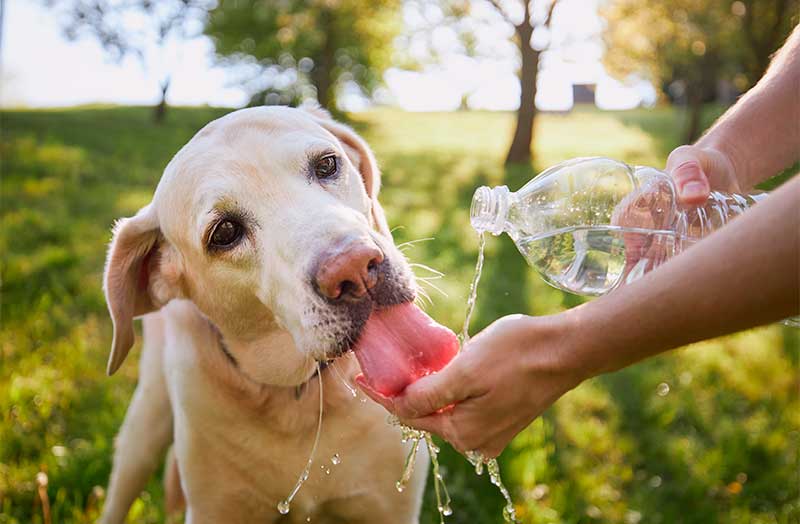
As our hot and muggy North Carolina summer temperatures rise, your pet’s heat-related injury risk also increases. During the summer, our Animal Emergency Hospital and Urgent Care team treats many heat-related injuries, including life-threatening heatstroke. Keep in mind that, despite expert treatment, some pets do not survive heat-related conditions.
Avoid summer heartbreak, and protect your pet from heat-related injuries by following our five heat safety tips. Feel free to share this information with all your pet-loving friends, so they too can protect their pets from unnecessary heat-related hazards.
How your pet regulates their body temperatures
We all have internal heat-regulating systems that return our body temperatures to the safe range when we are in a warm environment or after being physically active. Humans benefit from evaporative cooling on every skin surface, but for our furry friends to regulate their body temperature, they rely on panting and sweating an insignificant amount of perspiration through their paw pads.
In most circumstances, your pets’ panting and natural instincts to find water and shade help them avoid heat-related conditions. However, high humidity levels, unventilated environments, and the sun’s unrelenting rays can cause your pet to become hyperthermic (i.e., having a dangerously high body temperature), and develop heatstroke—a condition that can rapidly cause organ damage, organ failure, and death. For detailed heatstroke information, check out this article.
Fortunately, you can prevent your pet from developing heatstroke and other heat-related injuries by keeping in mind the following five heat safety tips.
#1: Never leave your unattended pet in a parked vehicle
Promising your devoted pet you will return in a minute as you close your parked car’s door could be the last thing they hear, whether or not you crack open the windows.
Every year, countless dogs and cats suffer heat-related injuries and death after being left unattended in a parked vehicle. A mild 70-degree temperature day turns the inside of your vehicle to a suffocatingly hot, humid greenhouse, and cracking open the windows does little to alleviate rapidly rising temperatures. As your trapped pet begins to overheat, their natural panic intensifies, accelerating heatstroke’s onset.
Never leave your pet in a parked vehicle—visit only pet-friendly businesses or leave your pet home. If you see a distressed pet trapped inside a vehicle, immediately notify the local authorities—never attempt a rescue on your own.
#2: Ensure your pet has access to water and shade while outside
Summer means outdoor activities, but you must be extra cautious when with your pet. Easy and effective ways to help your pet beat the heat include:
- Water — Regularly refill your pet’s water bowl with fresh tap or bottled water—avoid natural water sources that can be contaminated with algae, parasites, and bacteria, and swimming pool water that contains harmful chlorine and salt. In addition, water in metal bowls and the bowls themselves heat up quickly, so keep your pet’s water cool longer by using ceramic or plastic bowls
- Shade — Place your pet’s outdoor essentials under a shady tree or roofed porch, or create a shady space with an umbrella or shade cloth.
- Cool resting spot — If your pet likes to lounge outside with you, give them an elevated mesh pet cot that improves air flow or a cooling mat that helps reduce their body temperature.
#3: Adjust your pet’s exercise routine
Exercise is a natural stress reliever, and can help your pet feel less anxious and behave appropriately. Ensure your pet continues to exercise safely during the summer months by adjusting their usual activity as follows:
- Beat the heat — To avoid the day’s dangerously high temperatures, your pet should exercise during the early morning or late evening.
- Reduce exercise intensity — To regulate their body temperature while exercising during hot weather, your dog’s cardiovascular system will be working extra hard, so cut back on high-impact workouts. Consider walking instead of jogging, and playing tug-of-war instead of fetch.
- Take breaks — Rest is good for you and your pet. Take regular breaks and offer your dog a small amount of water.
Respect water dangers — Swimming and retrieving can be a cool way to exercise, but the strongest swimmer can quickly fatigue while playing these physically demanding activities. Always practice pet water safety and monitor your dog around swimming pools and natural water bodies.
#4: Protect your pet’s paws from scorching surfaces
Asphalt, artificial grass, and dark surfaces can retain and radiate heat—reaching incredibly high temperatures on a sunny summer day. In 70-degree weather, asphalt can reach 125 degrees. Your dog’s paw pads can easily burn from prolonged contact with surfaces other than grass.
If you are unable to hold your palm comfortably to the surface for 10 seconds, the surface is too hot for your dog. Place boots on their feet, or walk on grassy paths.
While many pets’ heat-related injuries are preventable, accidents can occur. If your pet is experiencing a heat-related emergency, act immediately by calling Animal Emergency Hospital and Urgent Care to quell your pet’s worsening crisis, and prevent their potential death.
